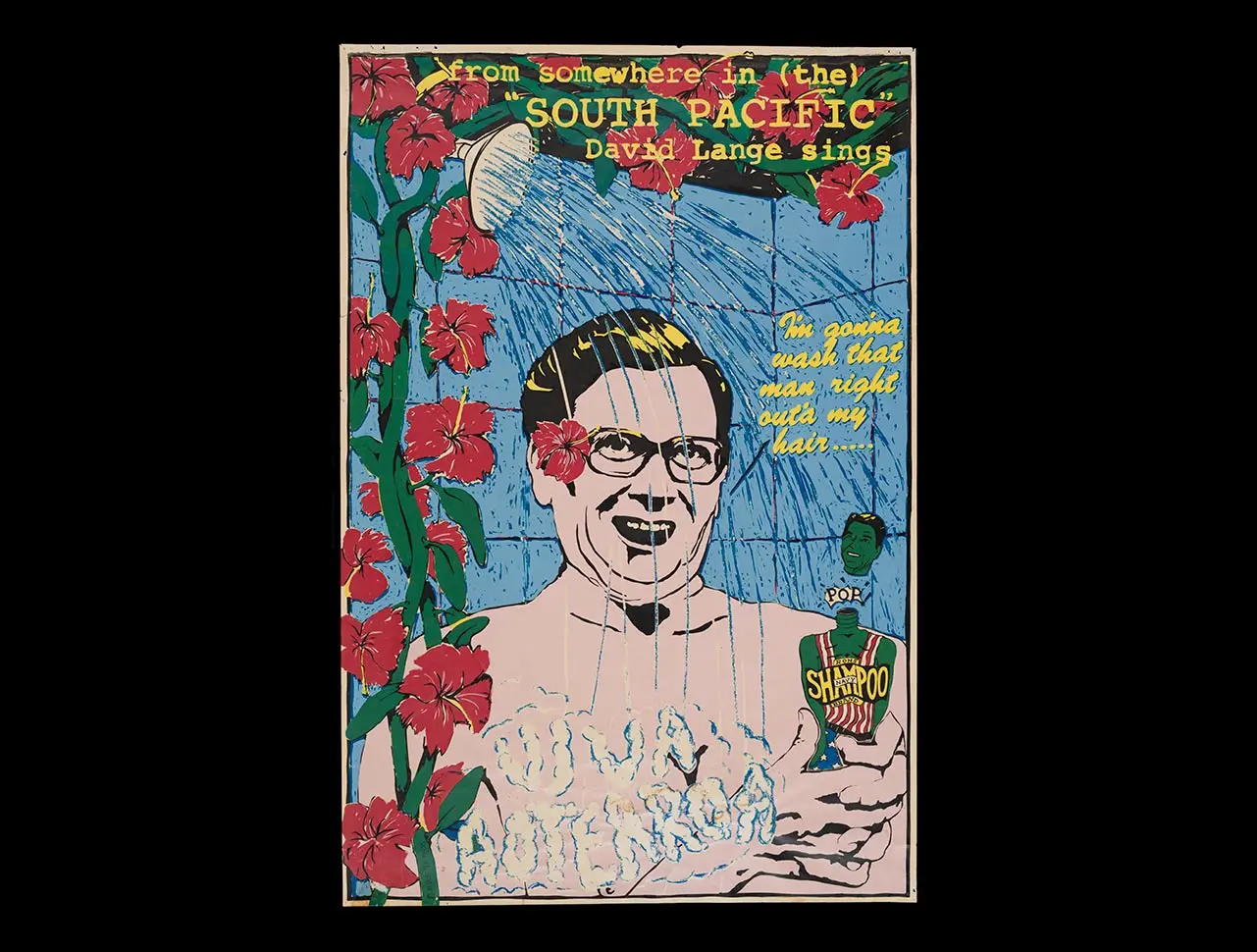Image credit: ‘I’m gonna wash that man right out’a my hair …’, ca 1984–1985 by Mark Denton. Ref: Eph-D-NUCLEAR-1985-01 Alexander Turnbull Library.

Image credit: ‘I’m gonna wash that man right out’a my hair …’, ca 1984–1985 by Mark Denton. Ref: Eph-D-NUCLEAR-1985-01 Alexander Turnbull Library.

Opposition to French nuclear testing in the Pacific grew in 1970s Aotearoa NZ. In the 1980s, the Government declared NZ a nuclear-free zone and banned visits by nuclear-powered warships. Find out more, and explore our collections and curated resources.
Prime Minister David Lange (1942–2005) was an unlikely poster boy for anti-nuclear protest, yet he seized the role with aplomb, declaring New Zealand a nuclear-free zone and in 1987 legislating accordingly. His decision was the culmination of a story that had begun with the first nuclear disarmament protests decades earlier.
France had been testing nuclear bombs in French Polynesia since the 1960s. In the 1970s, television footage of the mushroom clouds of atomic blasts on Mururoa Atoll, some 1250 kilometres southeast of Tahiti, brought the issue into New Zealand living rooms and onto the political agenda. International protests mounted, but the French ignored a cessation order from the International Court of Justice, and in 1973 Royal New Zealand Navy frigates sailed with Greenpeace vessels to Mururoa, to observe and protest the contamination of the South Pacific with radioactive fallout.
Eventually, the French bowed to political pressure and changed their approach to testing. But they were not happy. On 10 July 1985, two French Secret Service agents sank the Greenpeace ship Rainbow Warrior while it was moored in Auckland, killing crew member Fernando Pereira. The agents were convicted and returned to French territory for incarceration. They were released early and decorated for their work.
France was not the only country unhappy with New Zealand’s anti-nuclear stance. In 1985, United States warships were refused entry into New Zealand waters for declining to declare the presence of nuclear capability on board. This challenged long-standing security arrangements between the United States, Australia and New Zealand under the ANZUS Treaty, signed in 1951, and diplomatic relations turned frosty.
New Zealanders took some pride in standing up to bigger and wealthier countries on matters of principle. Lange was an articulate, compelling and occasionally irreverent spokesman. In a televised Oxford Union debate on nuclear issues in early 1985, he roundly defeated American televangelist Jerry Falwell. His quip alleging he could smell uranium on his opponent’s breath brought the house down and was reported with delight around the world. It was New Zealand’s moment.
Politicians are fair game in protest posters, and are often presented unfavourably. Cartoonist Mark Denton’s clever pastiche shows the opposite: a witty and irreverent homage to a job well done. The title springboards off the famed song from the 1949 hit musical South Pacific.
Story written by: Chris Szekely
Copyright: Turnbull Endowment Trust
Explore the Alexander Turnbull Library collections further: Anti-nuclear protest.
Topic Explorer has New Zealand protest.
Many Answers has Nuclear-free New Zealand.
Want to share, print or reuse one of our images? Read the guidelines for reusing Alexander Turnbull Library images.
Tikanga ā-iwi:
Te whakaritenga pāpori me te ahurea
Te ao hurihuri
Te wāhi me te taiao.
Te Takanga o Te Wā (ngā hītori o Aotearoa):
Whakapapa
Kaitiakitanga
Tūrangawaewae
Mana motuhake.
Social sciences concepts:
Identity, culture, and organisation
Place and environment
Continuity and change.
Aotearoa New Zealand’s histories:
Colonisation and its consequences
The exercise of power
Relationships and connections between people.